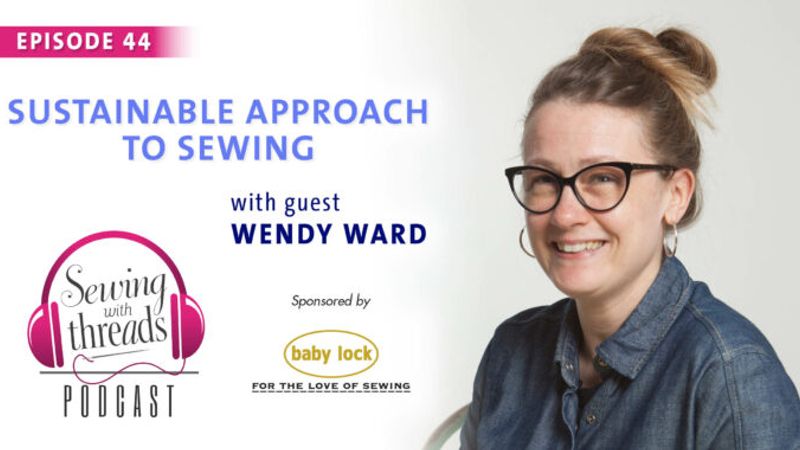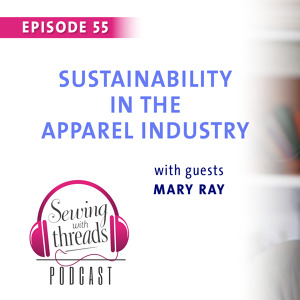Sustainable Approach to Sewing, with Wendy Ward | Episode 44
Make more, waste less, and enjoy the process
In this episode of the “Sewing with Threads” podcast, Threads staffers Sarah McFarland and Carol Fresia talk to Wendy Ward, author of several books on sewing.
Wendy Ward is a writer, designer, maker, and educator. She has worked as a designer in fast fashion and for a small sustainable brand. For her master’s degree in 2004 she explored novel ways to recycle textiles and, in 2007, she moved into education and has taught numerous garment-making, textile recycling, and garment alterations classes with adults. Wendy has her own line of sewing patterns called MIY Collection and has written five best-selling sewing books. Her most recent is How to Sew Sustainably (CICO books, 2021), which was published in June.
Her blog is www.wendyward.co.uk and you can find her on Instagram, Facebook, Twitter and Pinterest as @thatwendyward.
How to Sew Sustainably
Sarah and Carol ask Wendy how she decided on the topic of her latest book. She has been interested in issues of sustainability for years, since she finished her degree. She taught classes in recycled textiles and alterations, and these were popular. Known for beginner sewing books, she was excited to move in this new direction. Wendy praises her publisher, CICO, for their enthusiastic reception of her proposal on the topic of sustainable sewing.
Her goal was to provide novel content for her loyal readers, and to encourage a new audience to the joy of sewing. The book includes garment, home décor, and fiber arts projects. All the garments are based on body measurements, so there are no patterns needed. Sewers of any size can draft the patterns to fit, and some pieces are even suitable for children.
Combining fabrics
Wendy made her first sewing project by piecing together fabric scraps, so she has been making “new” textiles from the start of her career. She offers suggestions for successfully combining fabrics in a single garment. A benefit of working with fabrics harvested from older clothing is that the materials have already been thoroughly laundered. There’s little fear of further shrinkage or distortion.
A love for sewing education
Wendy fell into teaching during a period when she was working as a freelance designer. She found that work isolating and moved into teaching to make connections with other sewing instructors. Her first book, The Beginner’s Guide to Dressmaking (David & Charles, 2014), was the product of her experience teaching. She admits to receiving numerous rejections from publishers when she first proposed the book. However, this and her subsequent titles are popular and have remained near the top of Amazon.com’s list of sewing books for beginners.
Sewing as an art
Within her sustainability book, Wendy has arranged projects by materials: upcycled clothing, unconventional fabric sources (from serger scraps to large home linens), and remnants from previous garment projects. Among the projects are some wall art, pieced together from scraps. She is especially fond of these collage creations, because they incorporate materials that are meaningful to the sewer. Further, Wendy feels you can be bolder in combining materials in fabric collage than in garments. She enjoys stitching them by hand.
How to choose a sewing project
Wendy’s book encourages readers to evaluate their need for the project they are considering. This minimizes creating unneeded garments. In fact, she advocates making “boring” clothes, as they are the pieces that most people reach for again and again. Upcycling used garments to make new ones is a challenge, she acknowledges, and offers suggestions for sewing successful clothes. From color to pattern to the fabric’s hand, all aspects must be considered when you combine materials.
Bonus content on Wendy’s blog
Be sure to visit Wendy at www.wendyward.co.uk to get supplementary material associated with How to Sew Sustainably.

Baby Lock is so excited to introduce the launch of five new sewing, quilting, and embroidery machines: the Chorus, Ballad, Array, Vesta, and Flare.
These new machines come with a variety of innovative features and accessories, so you can prep less and sew more.
Features include wireless connectivity to easily transfer designs from your computer to machine, a guide beam to help you stitch straight lines, an automatic needle threader that threads your needle with little more than a push of a button, and plenty of sewing space for your large quilting, sewing and embroidery projects.
To check out these new machines, visit BabyLock.com.
We have created a podcast survey to help guide our content. Please take a moment to answer a few questions.




































Log in or create an account to post a comment.
Sign up Log in